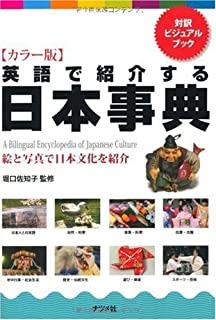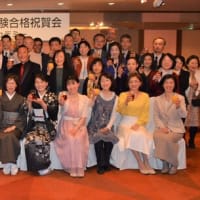
第2次口述試験の出典(タネ本)研究:英語で紹介する「日本事典」
本書は、2018年度、2019年度第2次口述試験<外国語訳問題>の出典(タネ本)であり、2022年度受験者が最も注意しなければいけない本です。
2018年度、2019年度に出題された箇所(ラーメン、桜前線、寿司、花火)の内容(出題ジャンル、出典から変更された日本文、日本文の長さ、など)をきちんと確認してメリハリのある学習を心がけてください。
すべての事項を暗記することはできませんし、また、その必要もありませんが、大事なことは、出題が予想される事項の日本文の中の「キーワード」(大体、2~3個くらい)となる言葉には日本文、英文の両方に蛍光ペンで印をつけて、覚えるようにしてください。
━━━━━━━━━━━━━━━━━━━━━━━
英語で紹介する「日本事典」とは?
━━━━━━━━━━━━━━━━━━━━━━━
●書名:英語で紹介する「日本事典」
●出版社:ナツメ社
●英語で紹介する「日本事典」(予想問題決定版)(キレイに印刷できます)
2018年度、2019年度に出題された箇所(ラーメン、桜前線、寿司、花火)の内容(出題ジャンル、出典から変更された日本文、日本文の長さ、など)をきちんと確認してメリハリのある学習を心がけてください。
すべての事項を暗記することはできませんし、また、その必要もありませんが、大事なことは、出題が予想される事項の日本文の中の「キーワード」(大体、2~3個くらい)となる言葉には日本文、英文の両方に蛍光ペンで印をつけて、覚えるようにしてください。
━━━━━━━━━━━━━━━━━━━━━━━
英語で紹介する「日本事典」とは?
━━━━━━━━━━━━━━━━━━━━━━━
●書名:英語で紹介する「日本事典」
●出版社:ナツメ社
●英語で紹介する「日本事典」(予想問題決定版)(キレイに印刷できます)
━━━━━━━━━━━━━━━━━━
2018年度出題実績【13:00~14:00】
━━━━━━━━━━━━━━━━━━
●<外国語訳問題>(ラーメン)
中国から日本に伝わったラーメンは、数百年を経て、日本人の国民食とも言える食品になりました。
日本人のラーメン好きは、評判店に長蛇の列ができることからもうかがえます。
めんの太さや具材、スープの製法、味付けなどにこだわり抜いたご当地ラーメンが、続々と登場しています。
●「日本事典」の日本文
中国から日本に伝わったラーメンは、数百年を経て、日本人の国民食とも言える食品になりました。
日本人のラーメン好きは、評判店に長蛇の列ができることからもうかがえます。
めんの太さや具材、スープの製法、味付けなどにこだわり抜いたご当地ラーメンが、続々と登場しています。
●「日本事典」の英語訳
Ramen was introduced into Japan from China.
Several hundreds of years have passed since then, and it has become a most favorite food of the Japanese.
And the unyielding love of ramen by the Japanese can be seen by the long lines formed at popular ramen shops.
The regional variations of ramen have gone onto national prominence.
Each of the regional variations focuses on secret recipes and the passionate pursuit of its own unique features such as the thickness of the noodles, ingredients, broth, and flavor.
━━━━━━━━━━━━━━━━━━
2019年度出題実績【13:00~14:00】
━━━━━━━━━━━━━━━━━━
●<外国語訳問題>(桜前線)
桜前線とは、桜の開花予想日を天気図の前線の移動のように日本地図上に示したものです。
桜の開花は、3月下旬に九州から始まり、次第に日本列島を北上し5月には北海道に達します。
桜の花を愛する日本人は、強い関心を持ってこの前線の動きを見て、春のお花見を楽しみにしています。
●「日本事典」の日本文
桜前線とは、桜の開花予想日を天気図の前線の移動のように日本地図上に示したものです。
桜の季節になると、気象庁の発表などをもとにテレビや新聞では毎日知らせます。
一般的に、桜前線は3月の沖縄から始まり、次第に日本列島を北上し5月には北海道に達します。
桜前線のニュースは日本人には、春の便りを実感できる楽しい知らせです。
●「日本事典」の英語訳
Sakura-zensen is a chart on a map of Japan predicting the date of cherry blossoms blooming just like a weather map showing the movement of frontal systems.
TV and newspapers report it every day based on the announcement of the Meteorological Agency of Japan as the season approaches.
Usually, sakura-zensen starts from Okinawa in March and, gradually going north along the Japanese Archipelago, reaches Hokkaido in May.
Sakura-zensen reports are happy news of spring for Japanese people.
━━━━━━━━━━━━━━━━━━
2019年度出題実績【14:00~15:00】
━━━━━━━━━━━━━━━━━━
●<外国語訳問題>寿司(B)
寿司の起源は、意外にも東南アジアとの説があります。平安時代に日本に伝わったとされ、当初は、魚の保存法としての意味合いが強かったようです。
江戸時代には、屋台が提供するファストフードでした。
新鮮な魚介類、海苔、油揚げなどの具材が使われ、地方ごとに特色があります。
●「日本事典」の日本文
寿司の起源は、意外にも東南アジアとの説があります。平安時代に日本に伝わったとされ、当初は、魚の保存法としての意味合いが強かったようです。
今日、海外でも人気の「スシ」は、「にぎり」もしくは「江戸前寿司」と呼ばれるものです。
江戸時代に、今より大きめににぎった寿司飯(酢をまぶしたご飯)に、「江戸城の前の海=江戸前」でとれた魚介類をのせたのが始まりで、江戸の屋台が提供するファストフードでした。
にぎり以外にも、寿司の種類はたくさんあります。
具と寿司飯を海苔で巻いた海苔巻き、寿司飯を油揚げで包む稲荷寿司、いろいろな具を丼に盛り付けるちらし寿司、保存食としての熟れ寿司など、地方ごとに特色があります。
●「日本事典」の英語訳
As hard as it is to believe, there is a theory that sushi originated in Southeast Asia.
It is said that sushi was introduced into Japan during the Heian Period (794 – 1185) and was originally made mainly to preserve fish.
Today sushi, mainly nigirizushi (literally, hand-formed sushi) or Edomae-zushi (Edo-style hand-rolled sushi), is also a very popular dish outside of Japan.
The origin of nigirizushi or Edomae-zushi is traced back to the Edo Period (1603 –1867) when it was made with freshly caught fish or other seafood from Edo-mae (Edo Bay or Tokyo Bay) over a bigger (than today's size) ball of vinegared rice and was served in yatai (street stalls) as an early form of fast food.
In addition to nigirizushi, there are other kinds of sushi—norimaki (literally, rolled sushi wrapped in nori), a cylindrical piece of sushi with various ingredients rolled inside the rice and then wrapped in nori (dried seaweed); inarizushi (literally, stuffed sushi), a pouch of fried tofu filled with vinegared rice; chirashizushi (literally, scattered sushi), a bowl of vinegared rice mixed with other ingredients; and narezushi (literally, matured sushi) as a preserved food. Each of these kinds of sushi represents the unique characteristics of the region where it originated.
There are unique sushi-related terms: shari for vinegared rice, gari for pickled ginger, murasaki for soy sauce, and agari for hot green tea.
━━━━━━━━━━━━━━━━━━
2019年度出題実績【15:30~16:30】
━━━━━━━━━━━━━━━━━━
●<外国語訳問題>(花火)
花火は日本の夏の風物詩の代表格です。7月と8月に集中して日本各地で花火大会が催され、多くの人々が詰め掛けます。夜空に美しい大輪の花が咲き誇り、一瞬で散っていくさまは、桜などと同様に、日本独特の価値観である潔さやはかなさを象徴するものです。大阪の天神祭では、たくさんの花火が天満宮に奉納され、多くの舟の大行列とともに有名です。
●「日本事典」の日本文
花火は日本の夏の風物詩の代表格です。7月と8月に集中して日本各地で花火大会が催され、多くの人々が詰め掛けます。
夜空に美しい大輪の花が咲き誇り、一瞬で散っていくさまは、桜などと同様に、日本独特の価値観である潔さやはかなさを象徴するものです。
花火が日本に伝来したのは鉄砲と同時期の16世紀。以後、改良や開発を繰り返して現在に至り、世界に誇る伝統芸能として毎年の夏を華やかに彩ります。
●「日本事典」の英語訳
Hanabi (fireworks) are the most important part of Japanese summers.
Many people flock to the fireworks festivals that take place all over Japan in the months of July and August.
Similar to cherry blossom viewing in the spring, the way a beautiful and large flower blooms in the night sky only to scatter in a moment is symbolic of the grace and transience which so many Japanese people value.
Fireworks were introduced to Japan around the same time as guns—the 16th century.
With repeated improvements and developments since then, fireworks, as they sparkle in the summer sky, are a traditional entertainment of Japan that can proudly be presented to the world.
以上























